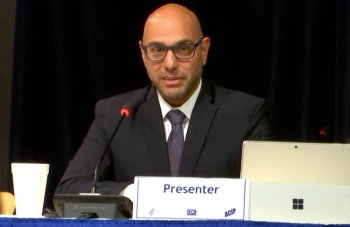
Why COVID-19 is hitting minority populations hard
What needs to be done to improve the outcomes of underserved populations.
Jay Bhatt, DO, is an internist and public health expert who previously served as the chief medical officer of the American Hospital Association. Bhatt has studied how underserved populations are affected by inequities in healthcare, and how the COVID-19 crisis is hitting many of these communities particularly hard.
Medical Economics spoke with Bhatt about why minority populations have higher infection and fatality rates during the pandemic and what can be done to change that. The following transcript has been edited for brevity and clarity.
Medical Economics: Why are minority populations dying from COVID at double the rate of whites in some cities?
Jay Bhatt: I think we're seeing some stark numbers on this, and it's illuminating an issue that's been in play for a long time and that's really inequities. Simply put, the issues of poverty, chronic Illness, stress, and discrimination worsen the body's ability to respond to challenges to the immune system. We're also seeing that these individuals have chronic diseases, disproportionately higher rates compared to white Americans, and then we're seeing that they aren't able to access care as effectively as those that are white. We're also seeing that there are issues around racism that make it harder for them to be engaged in the appropriate care or feel like they can't access care when they need it. It's just incredible to see situations in which some of the data shows that you when you look at census tracts in which they're more than 13% African American populations, they are experiencing death at 60% and cases at 50% proportionally. So it's just a challenging situation, and fortunately, illuminates an issue that we've got to try to bend the curve on.
ME: What role does food insecurity play in the COVID health risk among low income populations?
JB: We know that food insecurity has implications for health outcomes. The data suggests that those that are food insecure are experiencing poor health outcomes at 40% or more than those of populations that aren't. We're seeing so many people line up for food pantries, food shelters. Not too long ago, you saw images of thousands of cars in a San Antonio parking lot, waiting for food. If you don't have food that's adequate or appropriate, it's going to have an impact on your health conditions, particularly chronic conditions. You can't take your insulin properly if you don't have food that you can eat. You're also more prone to eat food that's unhealthy. If you're food insecure, you also have this situation where you may have to go out to get food and that exposes you to the virus potentially. One thing that happened in 2016 was that the USDA, as a result of legislation in the Obama administration, allowed for digital use of food stamps. The more that we can make it easier for underserved populations, those that are poor, and secure access to groceries or the food they need without exposing themselves the more likely they're going to be healthy.
ME: What else can be done to improve COVID outcomes for these communities?
JB: One, I think we need to continue to double down on is testing in those communities, making sure that we're identifying those folks that are positive and those that are at risk and getting them the care that they need. The other is, I think, lifting up and calling out issues that affect them, whether it be under-resourced, under-invested neighborhoods, racism, and other policy systems and environmental changes that are putting them at risk for poor outcomes. The other thing we can do is being able to offer the use of food stamps digitally or the other options - are you getting them the care that they need and making it easier for them right now? Many of those communities live also in fear of both what might happen to them if they access care, or immigration is an issue, and so they may not be accessing the care that they need. So we're seeing those with chronic disease not coming to access care, although telemedicine has made things better and provided some access. They're still not coming to the hospital potentially at the same rates that they were before and it's not like the prevalence of cardiac disease or stroke or abdominal conditions has changed. We need a concerted effort to improve social services, as opposed to just medical services. We're the only developed country in the world where that imbalance exists where we spend more on medical care than social care. We've got to invest in the health of community. It's not about just treating a patient, but about treating the neighborhood.
ME: With so many patients deferring their non-COVID care because of the pandemic, how will this behavior affect underserved communities in the long run?
JB: I think it will continue to widen the disparities that exists and we'll be further behind the eight ball in trying to improve the health of these communities. We know that when you look at the issues of life expectancy, such as from The Loop here in Chicago compared to the west side, there are stark differences in life expectancy in just a short time. I think that those things will continue to be proliferated if we don't make changes about how we think about the social needs, social determinants, and health equity-related issues.
ME: Why is it important to carefully track COVID outcomes by race so that we can better understand how this pandemic is affecting different communities?
JB: I think we know that you can't improve what you don't measure. So first you have to have the data to understand where improvement is needed and where the targeted efforts are needed. I also think that with the preventive measures, whether it be social distancing, whether it be testing and isolation, the use of those measures can be accelerated and escalated in places where we know there's going to be higher risk and the data can help us with that. That data can also help us understand the challenges that these populations may have been having in access, testing and getting the care that they need. But also, we need to make them more comfortable with contact tracing. You know, there may be situations where these populations may not want to answer calls or give out information or engage in contact tracing. And so it requires investing in community health workers and other strategies so that we meet people where they're at and make them comfortable with the process. Now, the data allows us to understand once we have it to drop an intervention in those communities. You have to have a baseline and then show where the progress is and where the challenges are, and then that allows us to lift up those practices that are promising and that are working.
ME: What role does government play in the solution to these issues?
JB: I think government has a critical role to play. Look at the policy levers that can help impact the journey to eliminate health disparities, whether it be transportation, food insecurity, and other areas where we're seeing social isolation. This also can be an important area that could be impacted by some of the policies and cities. There are opportunities to enact a health and policies framework. There are things like taking underinvested neighborhoods and re-designing them and investing in them so you lift up the community's ability to be healthy. The government can also improve the way that they design and deliver on Medicaid and Medicare. We're seeing Medicare Advantage allow for reimbursement for social needs. And that can be important in the Medicaid population as well. And the use of telemedicine and phone calls and reimbursing that care appropriately, I think is critically important.
I would go back to the issues of just creating the opportunities for healthy communities and looking at all the factors that may impact that that community. So for example, I asked the question in the state of Illinois, looking at claims data, which county has more lower extremity amputations related to diabetes, and it turns out that it was a small county in the southern part of Illinois that proportionally, when you control for everything and compare against other counties with loss from amputations related diabetes, they were at 50 times more than Cook County, which isn't a surprising fact. But when you look deeper in the data and peel the onion, you see that they had the worst primary care access, that they had the most liquor stores per capita of any county, and they have the least space for physical activity and fitness. So you see how the community is structured and what's there has implications for how fast a chronic disease might accelerate and not be taken care of. So from ensuring that we have the best Medicaid and Medicare plans available, both from delivery models that we're seeing working from CMMI, to doing more of these experiments that help us understand what's working, and then looking at other policies to make it easier for our public that's at risk in those communities to stay safe. And then third is just economic mobility and education. I think policies and systems to help that is critically important.
ME: What can individual physicians do to help these underserved communities, especially in these trying times?
JB: I think individual physicians can continue to share their stories. We're seeing a lot of stories come out from the COVID pandemic of how certain populations, particularly people of color, are experiencing health care and experiencing this pandemic. And I think we need to lift those up, identify opportunities for action, but then also lifting up those practices that are working well and are positive ones that we could scale and grow. I think the other thing physicians can do is begin to build capacity further on social needs and social determinants and how do you screen and how do you think about your care. So for example, if someone is coming in with a set of symptoms that could also be explained by their living situation or by poverty or by the stress and discrimination that they might be experiencing, it's important to understand that. So I think we've got to also help physicians apply what they know from the quality world, using robust approaches to quality improvement, and apply it to the issues of inequities. Because I think if you deploy an intervention, study it, measure it, and then use it to improve care, we can make a big difference and that's what we've done with quality.
Newsletter
Stay informed and empowered with Medical Economics enewsletter, delivering expert insights, financial strategies, practice management tips and technology trends — tailored for today’s physicians.















